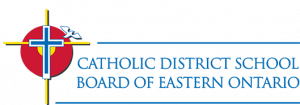Renewed Math Strategy Provides Intensive and Targeted Curriculum
CDSBEO has engaged in rigorous and purposeful Renewed Mathematics Strategy programming and learning for both students and staff over the past two years. This plan aligns with the Ministry of Education’s focus on increasing student achievement, increasing educator math knowledge, and building capacity in the area of mathematics.
Principal of Curriculum Dawn Finnegan, and Curriculum Consultant Patrick McLeod, presented details of the CDSBEO Renewed Math Strategy to the Board of Trustees. This is the second year of Ontario’s Renewed Math strategy (RMS) and the CDSBEO continues to take intensive and targeted steps to improve mathematics achievement across the Board.
“The Ministry of Education has clearly outlined the four main objectives of Ontario’s Renewed Mathematics Strategy. The first priority is focused on increasing student achievement, well-being and engagement in mathematics,” began Mrs. Finnegan. “We want our students to understand and have a growth mindset towards mathematical learning. Naturally, the second objective is to increase educator math knowledge and their pedagogical expertise; this priority will help teachers as they continue to enhance and engage their students in innovative approaches to learning mathematics.”
She continued, “The third area of focus is to increase leader knowledge of effective mathematics pedagogy which will continue to contribute to system improvement. Finally, the fourth objective is another fundamental piece of improving achievement in mathematics, which is increasing parent engagement in their children’s mathematical learning. Our presentation tonight will outline the many ways that the CDSBEO is ensuring that these key objectives are being fulfilled.”
The CDSBEO has created a Numeracy Learning Cycle that has been in place since 2017. There are a number of integral components that allow educators and school leaders to come together to collaborate and share best practices around mathematics education. These components include: the Principal Advisory Committee, a leadership steering committee unique to CDSBEO in Eastern Ontario; the Leaders in the Middle sessions, which brings together principals, special education teachers and mathematics leads from each school to provide guidance and resources to help school teams increase student achievement in mathematics; the Regional Math Sessions, a joint effort between the Curriculum and Special Education Departments that emphasizes both the mathematic curriculum expectations and essential strategies and supports for all students, as well as students with additional learning needs; and, the school-based Divisional Math Meetings, which take place three times per year, and give school teams an opportunity to examine the strategies discussed at the Regional Meetings, as well as the Leaders in the Middle sessions. These professional development opportunities are an excellent means to build teaching capacity, and to encourage educator collaboration and learning.
A number of mathematics resources have also been developed by the board to help ensure supportive math learning for students.
“The Curriculum Department’s Weekly Tips highlights resources that can be used in the classroom,” explained Curriculum Consultant Patrick McLeod. “Over the past two years, this weekly email has included a math puzzle of the week. The purpose of the puzzle is to have students think critically about mathematics and how they can use their knowledge of computation to solve the value of each puzzle piece. Amazingly, these puzzles have taken off, and students are now building their own puzzles to share with their peers.”
Students have described the puzzles as a fun and engaging way to learn mathematics and solve problems.
The Curriculum Department also released Olympic themed resources in the areas of numeracy, literacy, French as a second language, Indigenous studies and Kindergarten. The math team provided schools with math questions for every strand in the primary, junior and intermediate divisions. Teachers appreciated these resources as it demonstrated ways to make cross-curricular connections between mathematical concepts and an important global and cultural event.
Technology is also used across the Board to help engage students in math learning. Tools include Dreambox, Math is Visual, and Explain Everything. These tools help students to assess and learn math through varied means, including images, visuals, videos, spoken words, games, and other activities.
Other events and professional development opportunities have been provided for educators at all levels, including the Early Years Math Collaborative Inquiry, Junior Numeracy Skill Builder Sessions, the Grade 9 Numeracy Foundations Course, Senior Math Tournaments, and Parent Math Nights to help engage parents in math learning.
